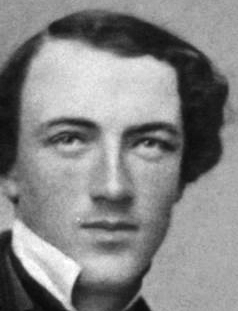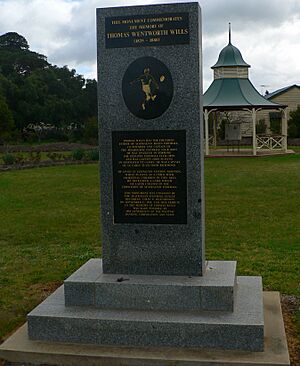Marn Grook facts for kids
Marn Grook or marngrook is a traditional Indigenous Australian football game. It was played by many people at special gatherings. The name comes from the Woiwurung language. It means "ball" and "game."
Players would kick and catch a ball made from animal skin. Many people played at once, sometimes over 100 players. The game was played across a very large area. There were rules about who could play together. For example, players had to be similar in size and gender.
To people watching from outside, the game looked like it had no teams or scores. There was no clear winner unless one side agreed the other played better. Players who kicked or leaped very high were often praised. But being good at the game did not give them special power in their tribe.
The first stories about Marn Grook came out after Europeans settled in Australia. These stories were from explorers and settlers in Victoria. Historical reports show it was played widely in south-eastern Australia. This included the Djabwurrung and Jardwadjali people. Other tribes in western Victoria also played it. Some say it was played as far as the Yarra Valley and Gippsland. The Warlpiri people in Central Australia played a similar game. They called it pultja. In Queensland, it was known as Purru Purru in the 1860s.
Some historians believe Marn Grook helped create Australian rules football. This game started in Melbourne in 1858. This connection is important to many Indigenous Australians today. Especially for those who love Australian rules football.
Contents
Early Accounts of Marn Grook
Historians agree that Marn Grook existed before Europeans arrived. But it's not clear how long it was played in Australia.
A newspaper article from 1906 said it was seen about a century before. This would mean it was observed in Australia's early days as a colony.
First Recorded Observations
The earliest story about Marn Grook is from around 1841. This was before the Victorian gold rush. Robert Brough Smyth wrote about it in his 1878 book. He quoted William Thomas, who worked with Aboriginal people. Thomas said he saw Wurundjeri people playing the game near Melbourne:
The men and boys joyfully assemble when this game is to be played. One makes a ball of possum skin, somewhat elastic, but firm and strong. ...The players of this game do not throw the ball as a white man might do, but drop it and at the same time kicks it with his foot, using the instep for that purpose. ...The tallest men have the best chances in this game. ...Some of them will leap as high as five feet from the ground to catch the ball. The person who secures the ball kicks it. ...This continues for hours and the natives never seem to tire of the exercise.
The Wurundjeri-willam clan loved this game. Teams were sometimes based on animal groups, like Bunjil (eagle) and Waang (crow). Robert Brough-Smyth saw the game at Coranderrk Mission Station. There, elder William Barak encouraged Marn Grook. He did not like imported games like cricket.

In 1855, William Anderson Cawthorne wrote about the Indigenous people of South Australia. He drew pictures of a sling and a ball. In the Kaurna language, a ball is called pando or parndo. His drawing had a note that said:
A group of children is playing with a ball. The ball is made out of typha roots (roots of the bulrush). It is not thrown or hit with a bat, but is kicked up in the air with a foot. The aim of the game – never let the ball touch the ground.
In 2007, a sketch from 1857 was found. It showed Victorian scientist William Blandowski watching a football game. The Latjilatji people were playing near Merbein. This was during his trip to the Murray River and Darling River.
Historian Greg de Moore said about the 1857 sketch:
What I can say for certain is that it's the first image of any kind of football that's been discovered in Australia. It pre-dates the first European images of any kind of football, by almost ten years in Australia. Whether or not there is a link between the two games in some way for me is immaterial because it really highlights that games such as Marn Grook, which is one of the names for Aboriginal football, were played by Aborigines and should be celebrated in their own right
An eyewitness in 1860 described a "great game of football." It was played by an Aboriginal group near the Broken River. This game started their celebrations.
In 1889, anthropologist Alfred William Howitt wrote about Marn Grook. He said large groups played based on their totems. For example, white cockatoos versus black cockatoos. Players who could leap or kick the highest were praised. Howitt wrote:
This game of ball-playing was also practised among the Kurnai, the Wolgal (Tumut river people), the Wotjoballuk as well as by the Woiworung, and was probably known to most tribes of south-eastern Australia. The Woiworung made it of tightly rolled up pieces of possum skin. It was called by them "mangurt". In this tribe the two exogamous divisions, Bunjil and Waa, played on opposite sides. The Wotjoballuk also played this game, with Krokitch on one side and Gamutch on the other. The mangurt was sent as a token of friendship from one to another.
In 1929, David Unaipon talked about an "ancient game." He said his people played with a ball of hair and emu feathers. Teams tried to keep the ball from their rivals.
By 1906, the name Marn Grook was well known. Newspapers described it as a dying tradition. They said the ball was about 6 inches (15 cm) in size.
Another story from 1934 described Marn Grook rules near Melbourne. The highest kicker won the game. Elders taught the game. Girls also played, but they threw the ball instead of kicking it.
Marn Grook and Australian Rules Football

Since the 1980s, some people have suggested a link. They think that Tom Wills, a founder of Australian rules football, was inspired by Marn Grook.
This idea is based on stories and clues. Tom Wills grew up in Western Victoria. As the only white child there, he reportedly spoke the Djab wurrung language. He often played with local Aboriginal children on his father's farm. This story has been passed down in his family.
Col Hutchison, a former historian for the AFL, supported this idea. His account is on an official AFL memorial to Tom Wills in Moyston. It was put up in 1998.
While playing as a child with Aboriginal children in this area [Moyston] he [Tom Wills] developed a game which he later utilised in the formation of Australian Football.
However, sports historian Gillian Hibbins disagrees. She researched the history of Australian rules football for the AFL. She says there is no proof that Marn Grook was played where Wills grew up. She thinks it's unlikely Wills played the game. Her views caused some debate.
James Dawson, in his 1881 book Australian Aborigines, described a game like football. Players kicked a ball made of possum fur.
Each side endeavours to keep possession of the ball, which is tossed a short distance by hand, then kicked in any direction. The side which kicks it oftenest and furthest gains the game. The person who sends it the highest is considered the best player, and has the honour of burying it in the ground till required the next day. The sport is concluded with a shout of applause, and the best player is complimented on his skill. The game, which is somewhat similar to the white man's game of football, is very rough...
In his book, Dawson listed the word Min'gorm for the game. This was in the Chaap Wuurong language.
Professor Jenny Hocking and Nell Reidy have also found stories of the game. They found accounts of it being played where Tom Wills grew up.
Historian Mark Pennings studied the early years of Australian rules football. He found no proof that the first rule-makers were influenced by Marn Grook. Trevor Ruddell, a researcher, wrote in 2013 that Marn Grook had no clear link to Australian football's development.
Chris Hallinan and Barry Judd say that the history of Australian Rules has been too focused on European origins. They believe it has not fully recognized Indigenous contributions.
Similarities to Australian Rules Football
People who support the link point to similarities. In both games, players catch a kicked ball (a "mark"). They also jump high to catch the ball (a "spectacular mark"). However, this connection is just a guess. High marking only became common in Australian rules football in the 1880s.
The Term "Mark"
Some people claim the word "mark" in Australian rules football comes from Marn Grook. They say it comes from the Aboriginal word mumarki, meaning "to catch." But the word "mark" has been used in football and other games since the 1500s. It likely comes from players marking the ground where a catch was made.
Marn Grook in Popular Culture
Because of the ideas about shared origins, Marn Grook is important in Australian rules football and Indigenous culture.
A documentary called Marn Grook was released in 1996. Steve McGregor directed it.
In 2002, the Sydney Swans and Essendon Football Club started playing for the Marngrook Trophy. They play for it each year in the Australian Football League. This trophy honors Marn Grook. But the game itself is played under normal AFL rules.
Marn Grook is also the subject of children's books. These include Neridah McMullin's Kick it to Me! (2012). It tells the story of Tom Wills' childhood. Marngrook: The Long Ago Story of Aussie Rules (2012) is by Indigenous writer Titta Secombe.
The Marngrook Footy Show is an Indigenous version of the AFL Footy Show. It started in Melbourne in 2007. It has been shown on National Indigenous Television and other channels.
See also
- Origins of Australian rules football
- Medieval football
- Lacrosse
- Lelo burti
- Yubi lakpi


